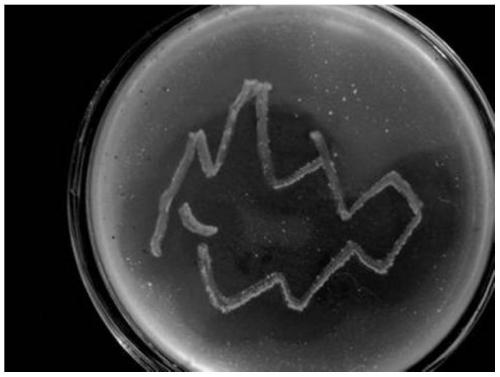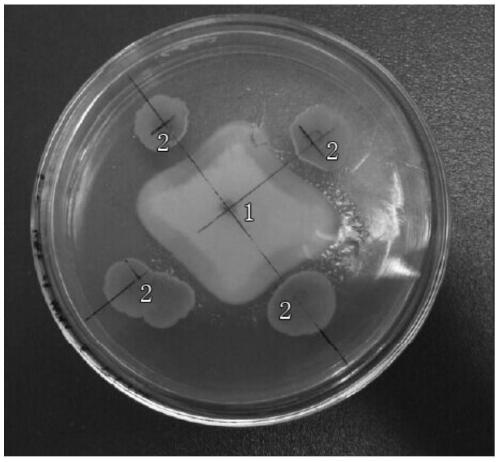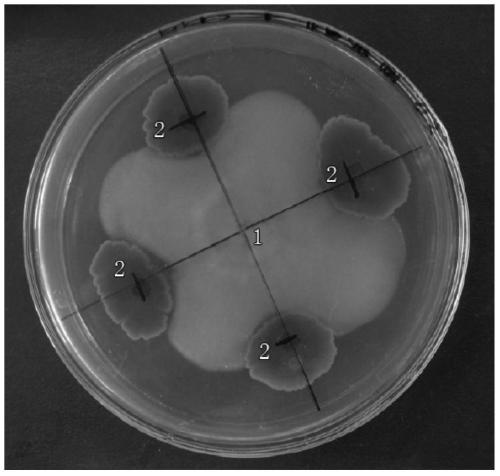A kind of bacterial strain and application for preventing and treating soil-borne fungal diseases of continuous cropping peanut
A soil-borne fungus and peanut technology, applied in the field of intensive agricultural production, can solve the problems of high application cost, large dosage, unstable control effect in the field, etc., achieve low cost, reduce the base of pathogenic bacteria, and significantly increase the effect of production
- Summary
- Abstract
- Description
- Claims
- Application Information
AI Technical Summary
Problems solved by technology
Method used
Image
Examples
Embodiment 1
[0033] Collect the peanut rhizosphere soil of a continuous peanut field in the red soil area for related experiments. The specific steps are:
[0034] (1) Soil sample treatment: Prepare sterilized enrichment medium (Ingredients: fine powder chitin 2.5g, MgSO 4 ·7H 2 O 0.5g, K 2 HPO 4 0.7g, KH 2 PO 4 0.3g, FeSO 4 ·7H 2 O 0.01g, distilled water 1000ml), divide 20ml into a sterile Erlenmeyer flask, and add 1.0g of fresh soil sample to the Erlenmeyer flask, mix, and incubate at 150r / min for 48h at room temperature to obtain an enriched culture solution.
[0035] (2) Coating separation: Pipette 1mL filtrate into 9.0mL sterile water, and dilute 3 times to obtain a dilution of 10 -4 Dilute the sample solution in a gradient. Spread 0.02 mL of the soil dilution solution on the plate separation medium and incubate at 28°C for 4-7 days. Observe and pick out the bacterial strains producing transparent circles.
[0036] (3) Cultivation and purification: pick a single colony and draw a line on a pl...
Embodiment 2
[0042] Example 2: Bacteriostatic experiment on various soil-fax type pathogens
[0043] Use the strain with the deposit number CGMCC NO.11539 for antibacterial experiment: first activate the strain, inoculate the pathogenic fungus in the center of the PDA plate, punch holes on the edge of the pathogenic colony with a diameter of 5mm to make a bacterial cake, and then connect it Go to the center of the PDA plate, and then inoculate the bacterial strains to be tested about 2.5cm away from the pathogens around the petri dish. Three replicates of each bacterial strain, culture for one week at 28°C, observe whether a zone of inhibition is produced, and determine the colony diameter of pathogenic fungi by the cross method , Calculate the inhibition rate. The selected pathogens are: Rhizoctonia solani, Fusariumsolani, Fusarium oxysporum f.sp.diath, Verticilliumdahliae Kleb, such as figure 2 — Figure 5 It was found that the strains had good antibacterial effects on the above-mentioned ...
Embodiment 3
[0046] Example 3: Greenhouse in vivo control experiment
[0047] The peanut root rot pathogen (Fusarium solani rot) was activated in the PDA medium and cultured at 28°C for 7 days. The spores of the pathogen on the medium were washed with sterile water. The bacterial solution was filtered with sterilized filter paper to remove the hyphae. Dilute the filtrate with appropriate distilled water to a spore concentration of 1×10 7 A / mL suspension, set aside.
[0048] Add the tested biocontrol strains to the culture medium containing no fungal hyphae inducer (beef extract 3%, peptone 8%) for liquid fermentation (26°C, 72h, 200rpm), and then inoculate decomposed pig manure at a rate of 5% Compost the substrate, place it in a constant temperature box (28°C) for 5 days, and use it as bacterial agent A for use.
[0049] At the same time, according to the same method as above, except that the inactivated fungal mycelial inducer (3%) is added to the liquid medium to carry out antibacterial enhan...
PUM
 Login to View More
Login to View More Abstract
Description
Claims
Application Information
 Login to View More
Login to View More - R&D
- Intellectual Property
- Life Sciences
- Materials
- Tech Scout
- Unparalleled Data Quality
- Higher Quality Content
- 60% Fewer Hallucinations
Browse by: Latest US Patents, China's latest patents, Technical Efficacy Thesaurus, Application Domain, Technology Topic, Popular Technical Reports.
© 2025 PatSnap. All rights reserved.Legal|Privacy policy|Modern Slavery Act Transparency Statement|Sitemap|About US| Contact US: help@patsnap.com



